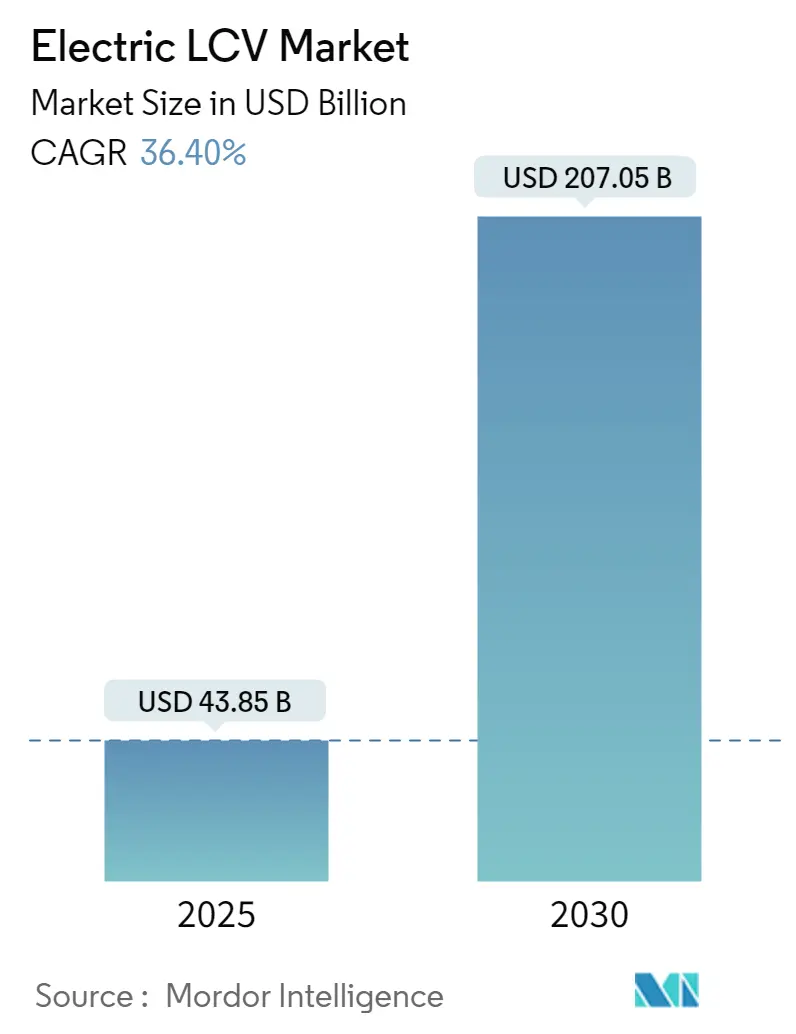
| Study Period | 2019 - 2030 |
| Market Size (2025) | USD 43.85 Billion |
| Market Size (2030) | USD 207.05 Billion |
| CAGR (2025 - 2030) | 36.40 % |
| Fastest Growing Market | Europe |
| Largest Market | Asia Pacific |
| Market Concentration | Medium |
Major Players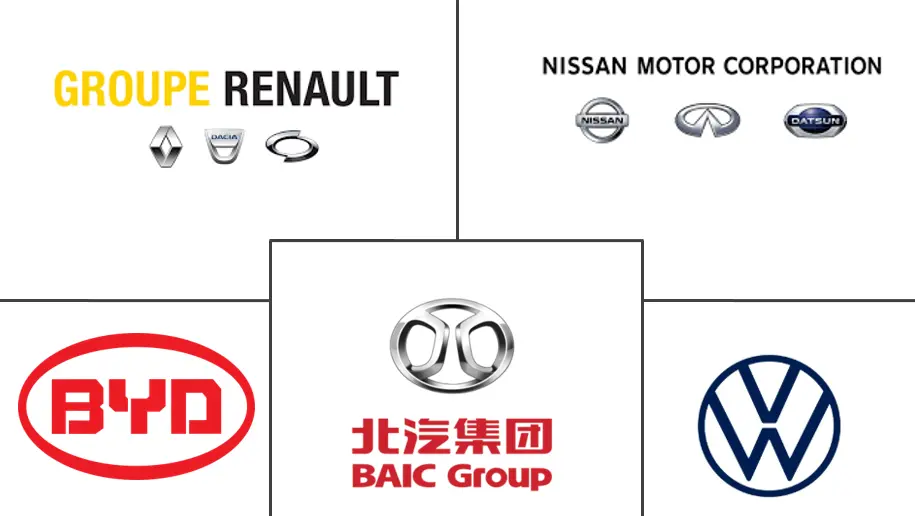
*Disclaimer: Major Players sorted in no particular order |
Electric LCV Market Analysis
The Electric LCV Market size is estimated at USD 43.85 billion in 2025, and is expected to reach USD 207.05 billion by 2030, at a CAGR of 36.4% during the forecast period (2025-2030).
- The rapid urbanization, stringent emission regulations, and advancements in battery technology are expected to fuel the demand for electric LCVs during the forecast period. The market is already witnessing the adaptation of electric passenger vehicles in developed countries, and the start-ups and major players in the LCV market are planning to introduce their new electric models in the coming years.
- Cities are restricting the access of diesel vehicles through the implementation of ultra-low emissions zones. Additionally, government grants, lower running and servicing costs, and access to ultra-low emissions zones can make electric commercial vehicles an attractive choice for business in the future.
- The EV battery range is growing rapidly. Presently, new models are being launched in the market witha range of up to 600 miles. Trucks and vans' body sizes are bigger compared to passenger cars, thus, they can accommodate more batteries for a longer range. Big electric motors can create enormous amounts of torque for towing and hauling capacities. For instance, Nikola's Badger pickup truck has a range of 600 miles, owing to its fuel cell technology and batteries.
Electric LCV Market Trends
Electric Van is Leading the Electric LCV Market
The population in urban areas is growing rapidly, owing to which, governments across the world are planning to ban diesel cars and vans. For instance,
- The United Kingdom is planning to ban sales of all types of gasoline and diesel engine cars by 2040. India is planning to ban all types of diesel-engine cars on the roads by 2030.
- Norway is way ahead of the curve, and it plans to make every new car a zero-emission car by 2025.
With the growing demand for electric vehicles, business owners have started replacing their existing fleets to electric vehicles, and market players are announcing the expected launch of their new electric models. In 2019, Ford announced its plans to launch its mass-selling Transit commercial van in an electric variant, named as Transit EV, in the European market by 2021. Vans contribute 80% of the total light commercial vehicle sales in Europe.
Vans are used for a wide range of commercial activities, such as construction, postal and courier services, ambulance services, policing and rescue operations, mobile workshops, and passenger transportation.
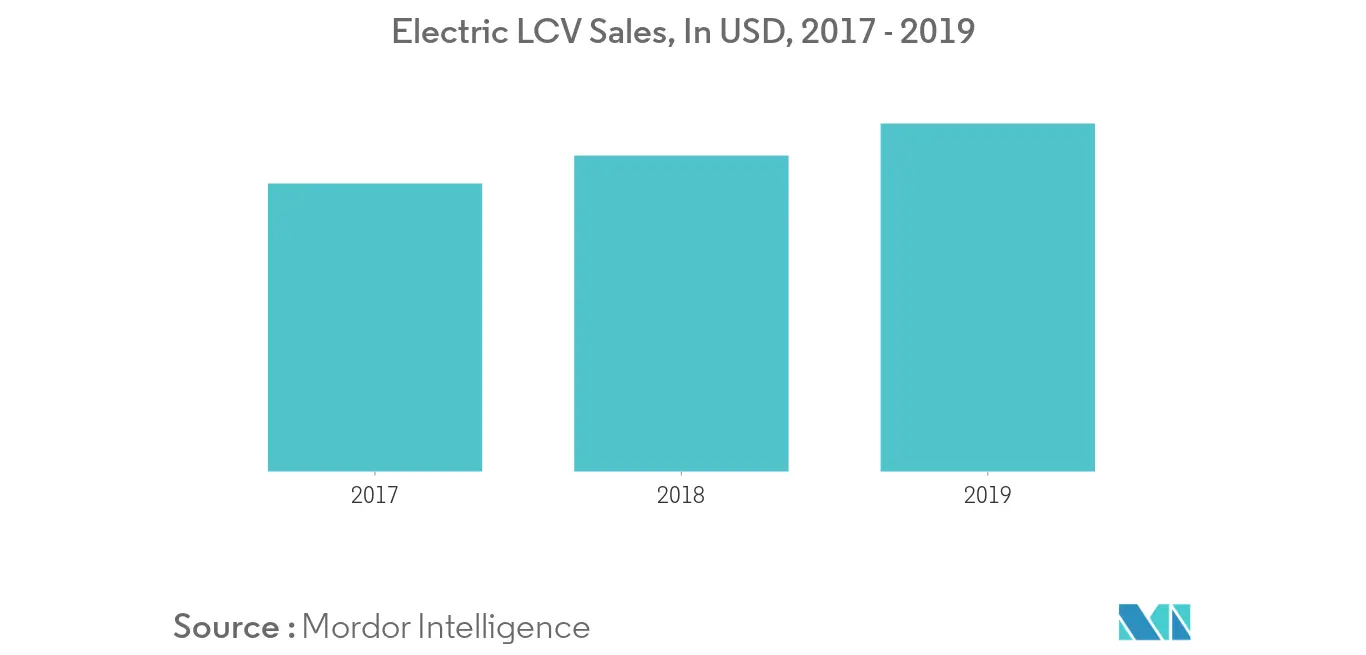
Asia-Pacific is Expected to Lead the Electric LCV Market
Asia-Pacific is the hub of the electric vehicle industry, owing to the availability of cheap raw materials, low labor cost, presence of numerous industry players, large population, and government participation. For instance, the Chinese government spent around USD 60 billion to support the electric-vehicle industry, including R&D funding, tax exemptions, and financing for battery-charging stations.
Chinese players, after performing well in their local markets, are trying to expand their market presence in other countries. For instance, in 2019, BYD Group, China's largest electric vehicle manufacturer, introduced its two pure electric commercial vehicles in India, namely, T3 pure electric commercial logistics minivan and T3 pure electric passenger MPV.
Europe is gaining traction in the market with the help of electric vans, and major players in the market are launching new electric vans in the region. For instance,
In 2019, Renault Group launched two hydrogen-electric commercial vehicles, namely, MASTER Z.E. Hydrogen and KANGOO Z.E. Hydrogen. The company is also increasing its range of vehicles from 120 km to up to 350 km.
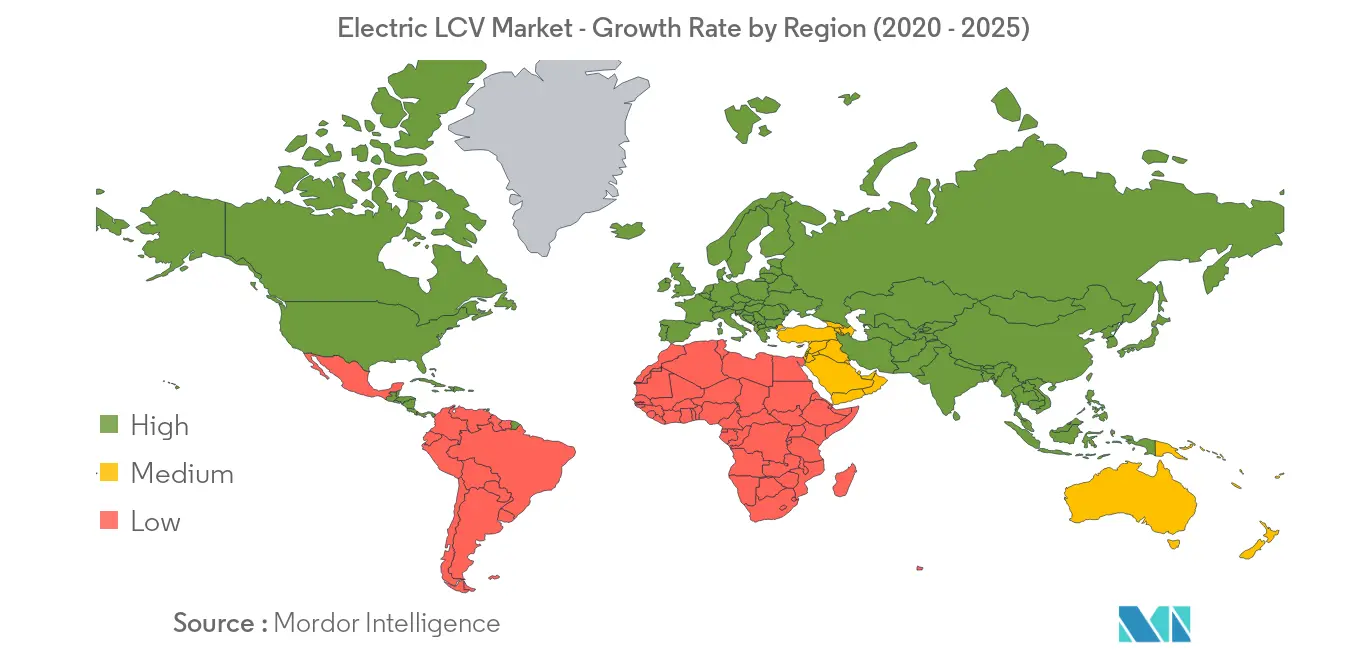
Electric LCV Industry Overview
The electric LCV market is moderately consolidated, and it has a limited number of active players. The market is witnessing the launch of various new electric models by start-ups and established players. Some of the major players in the market are BYD Group, Nissan Motor Co., Renault Group, and Volkswagen AG, among others. The companies are expanding their presence by forming strategic alliances with other players in the market and launching new electric LCVs. For instance,
- In 2020, Arrival, an electric van manufacturer, won a USD 428 million order from United Parcel Service (UPS) for 10,000 vehicles. UPS is also planning to buy an equity stake in the start-up. Arrival already received over USD 100 million in funding from Hyundai and KIA.
- In 2019, Rivian Automotive received a total of USD 1.3 billion in funding from different sources. Also, in September 2019, this start-up announced its plans to collaborate with Amazon for an electric delivery van, and a total of 100,000 of these electric vans have been ordered by Amazon, with deliveries expected to start by 2021.
- In 2019, Tesla launched its first electric pickup truck named Cybertruck, in Los Angeles, California. Cybertruck comes in three variants with a maximum range of 200 miles, 300 miles, and 500 miles, with the first delivery expected by 2021.
Electric LCV Market Leaders
-
BYD Group
-
Nissan Motor Co.
-
Renault Group
-
BAIC Group
-
Volkswagen AG
- *Disclaimer: Major Players sorted in no particular order
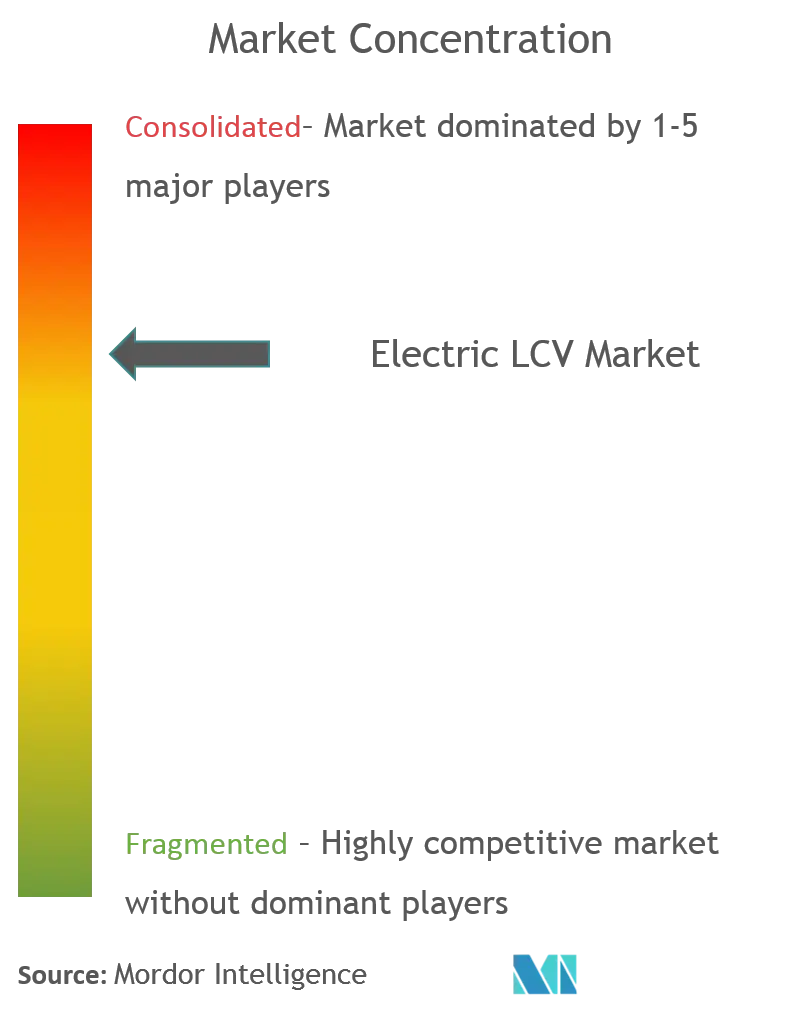
Electric LCV Market News
In February 2022, Nissan, Mitsubishi and Renault formed strategic alliance to fabricate 35 new segment electric vehicle. The French and Japanese companies strategic alliance will be together investing a sum of €23 billion for next five years. In addition, allianced have prepared plan to develop five common platforms, namely CMF-AEV, CMF-EV, KEI-EV, CMF-BEV and LCV-EV on which the majority of the upcoming EVs will be based.
In january 2022, India Industrial Giant Adnai announced its plan to ent indian electric mobility segment. Adani's entry in the segment will be major boost for the Indian commercial EV industry, which presently is in early growth stage and holds notable growth potential. Further, company declared that it shall potentially eye entry in the electric light commercial vehicles (LCV) and battery manufacturing business to push Indian electric vehicle industry.
In january 2022, UK electric LCV market witnessed a strong fell in overall sales by -26.9% with 17,566 registration compared to historic sales growth in EV LCV segment. In addition, this has been the challenging month for UK electric LCV market, although owing to changing consumer preferences and fleet renewable frrquecy shall exhibit strong come back for sales during the Q2 2022.
Electric LCV Industry Segmentation
The electric LCV market report covers the latest trends and technological development, changing infrastructure, and market shares of the major electric LCV manufacturers across the world.
| By Propulsion Type | BEV | ||
| HEV | |||
| FCEV | |||
| By Vehicle Type | Van | ||
| Pick-up Truck | |||
| By Power Output | Less Than 100 kW | ||
| 100 -250 kW | |||
| More Than 250 kW | |||
| By Geography | North America | United States | |
| Canada | |||
| Rest of North America | |||
| Europe | Germany | ||
| United Kingdom | |||
| France | |||
| Rest of Europe | |||
| Asia-Pacific | India | ||
| China | |||
| Japan | |||
| South Korea | |||
| Rest of Asia-Pacific | |||
| Rest of the World | Brazil | ||
| Mexico | |||
| United Arab Emirates | |||
| Other Countries | |||
Electric LCV Market Research FAQs
How big is the Electric LCV Market?
The Electric LCV Market size is expected to reach USD 43.85 billion in 2025 and grow at a CAGR of 36.40% to reach USD 207.05 billion by 2030.
What is the current Electric LCV Market size?
In 2025, the Electric LCV Market size is expected to reach USD 43.85 billion.
Who are the key players in Electric LCV Market?
BYD Group, Nissan Motor Co., Renault Group, BAIC Group and Volkswagen AG are the major companies operating in the Electric LCV Market.
Which is the fastest growing region in Electric LCV Market?
Europe is estimated to grow at the highest CAGR over the forecast period (2025-2030).
Which region has the biggest share in Electric LCV Market?
In 2025, the Asia Pacific accounts for the largest market share in Electric LCV Market.
What years does this Electric LCV Market cover, and what was the market size in 2024?
In 2024, the Electric LCV Market size was estimated at USD 27.89 billion. The report covers the Electric LCV Market historical market size for years: 2019, 2020, 2021, 2022, 2023 and 2024. The report also forecasts the Electric LCV Market size for years: 2025, 2026, 2027, 2028, 2029 and 2030.
Our Best Selling Reports
Electric LCV Industry Report
Statistics for the 2025 Electric LCV market share, size and revenue growth rate, created by Mordor Intelligence™ Industry Reports. Electric LCV analysis includes a market forecast outlook for 2025 to 2030 and historical overview. Get a sample of this industry analysis as a free report PDF download.




